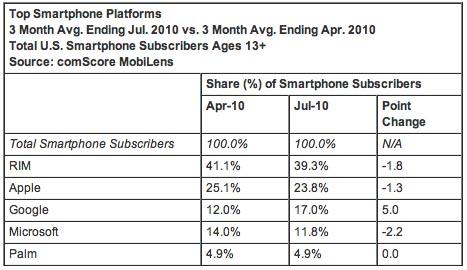
The folks at comScore have released their numbers that measure market share of the top smartphone platforms and mobile OEMs between April and July 2010, and the numbers match up well with what we've seen in the market lately. As with most reports that we've seen recently, RIM and their lineup of BlackBerrys are the top smartphone platform in the country with 39.3 percent market share as of July 2010. That number has been falling, though, as they had 41.7 percent when we reported on comScore's findings for May. Apple trails RIM with 23.8 percent market share, down from 24.4 percent in May. Unsurprisingly, Android has surged to third place and surpassed Microsoft with 17 percent of the market, compared to 13 percent in May. Microsoft is in fourth place with 11.8 percent and Palm is bringing up the rear with 4.9 percent.
When it comes to the top mobile OEMs, the race is a little closer, at least in the top three. Samsung leads the pack with 23.1 percent of U.S. mobile customers, followed by LG with 21.2 percent and Motorola with 19.8 percent. In fourth place is RIM with nine percent market share, and finally we have Nokia, which managed to capture 7.8 percent of the market.
For the three-month period of April 2010 to July 2010 that comScore measured for this report, Android was the only mobile OS to actually gain market share. We've all witnessed the explosive growth that Android has been having lately, so these numbers shouldn't come as a shock to anyone. What did surprise me a little, though, is the fact that Palm's webOS managed to hold steady at 4.9 percent during the entire stretch. Sure, they only have five percent of the market, but they also haven't released any new hardware for quite a while. I'm sure that webOS 2.0 will help the platform gain some market share, although some new handsets from the company would certainly help the situation. Along with webOS 2.0, Microsoft will be releasing its own new mobile platform in the near future. With Windows Phone 7, webOS 2.0, BlackBerry 6, iOS 4, and Android 3.0 all here or coming soon, I can't wait to see what these numbers will look like six months from now. What changes do you think we'll see?

Via comScore